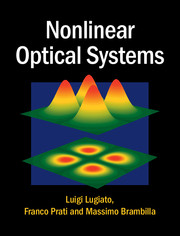Book contents
- Frontmatter
- Dedication
- Contents
- Preface
- Part I Models, propagation, stationary phenomena
- Part II Dynamical Phenomena, Instabilities, Chaos
- Part III Transverse optical patterns
- Appendix A The Routh–Hurwitz stability criterion
- Appendix B Calculation of the oscillatory instability boundary
- Appendix C Coefficients of the characteristic equation (20.20)
- Appendix D Derivation of equations (20.27) and (20.28)
- Appendix E Coefficients of equations (20.60) and (20.61)
- Appendix F The exact boundary of the Risken–Nummedal–Graham–Haken instability
- Appendix G Nonlinear analysis of the roll solution
- References
- Index
Part II - Dynamical Phenomena, Instabilities, Chaos
Published online by Cambridge University Press: 05 March 2015
- Frontmatter
- Dedication
- Contents
- Preface
- Part I Models, propagation, stationary phenomena
- Part II Dynamical Phenomena, Instabilities, Chaos
- Part III Transverse optical patterns
- Appendix A The Routh–Hurwitz stability criterion
- Appendix B Calculation of the oscillatory instability boundary
- Appendix C Coefficients of the characteristic equation (20.20)
- Appendix D Derivation of equations (20.27) and (20.28)
- Appendix E Coefficients of equations (20.60) and (20.61)
- Appendix F The exact boundary of the Risken–Nummedal–Graham–Haken instability
- Appendix G Nonlinear analysis of the roll solution
- References
- Index
Summary
In Part I of this book we studied almost exclusively stationary solutions of the models; we also mentioned in which parametric ranges they are stable or unstable, but without proving it. In this part we not only describe the technique used to assess the stability of stationary solutions but also, especially, study the temporal phenomena which originate from the instabilities themselves. As a matter of fact, the appearance of spontaneous pulsations in the form of undamped trains of pulses was first observed in masers even before the advent of the laser in 1960. However, a strong interest in temporal optical instabilities arose much later, in the early 1980s, in resonance, as it were, with the general interest in the field of chaos in nonlinear dynamical systems.
In Part II of the book we focus on the dynamical phenomena in nonlinear optical systems, of course taking the general viewpoint of nonlinear dynamical systems. In Chapter 18 we describe first the technique of linear-stability analysis and then we discuss the most relevant and general instability-related dynamical aspects in nonlinear dissipative systems such as, for example, attractors, bifurcations and routes to chaos. This provides the language to describe the results discussed in the following chapters of Part II. For reasons of space, we do not introduce technicalities such as, for instance, Lyapunov exponents.
In order to identify the instabilities, in general we prefer to use a procedure that is more direct than the Routh–Hurwitz stability criterion described in Appendix A. A more straight-forward technique is to calculate the stability boundaries in the space of the parameters of the system, as described in Section 18.1 and Appendix B.
In Chapter 19 we discuss the prominent transient dynamical features in class-A and class-B lasers, as is usual in textbooks on laser physics, whereas in the following chapters of Part II we discuss temporal instabilities and their consequences. In Chapter 20 we outline a general scenario that encompasses and structures all temporal instabilities that arise in the framework of two-level systems in ring cavities.
Information
- Type
- Chapter
- Information
- Nonlinear Optical Systems , pp. 205 - 208Publisher: Cambridge University PressPrint publication year: 2015
